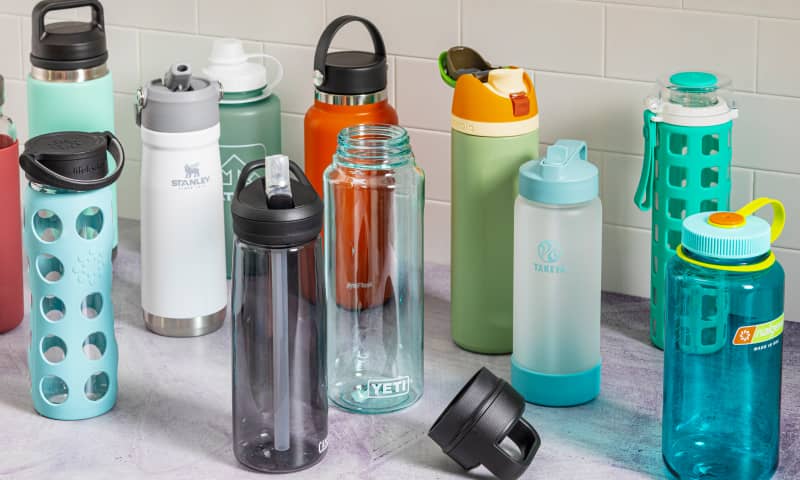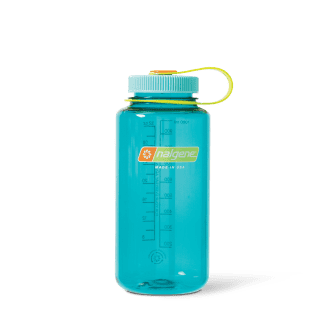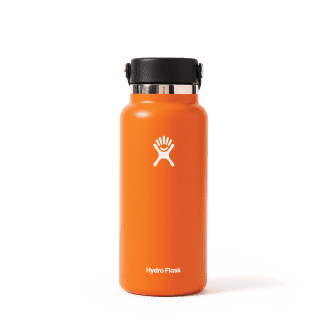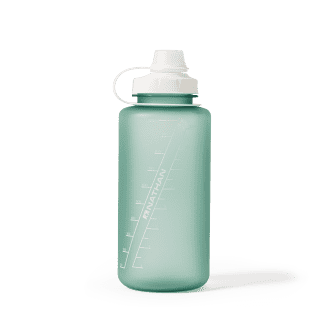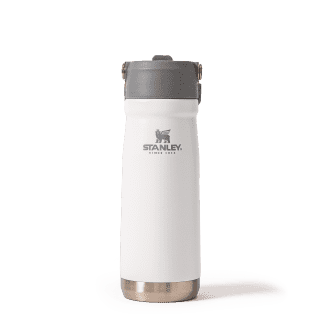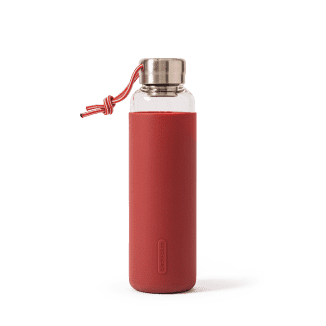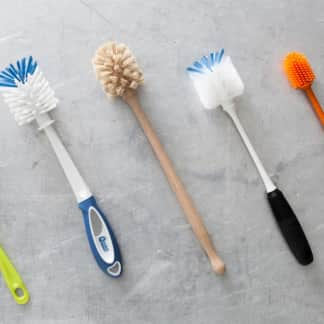Water bottles are made of different materials and come in various designs and sizes, which may make it hard to decide which one is right for you. We tested an assortment of models made from stainless steel, plastic, and glass and picked a winner in each category. Each of our winners is leakproof, easy to fill and drink from, and effortless to clean. Our favorite stainless-steel bottle, the YETI Rambler 26 oz Water Bottle, is durable and keeps water cold for more than 8 hours. Our winning plastic model, the YETI Yonder 1L/34 oz Water Bottle, is equally durable and relatively lightweight. Our favorite glass model is the Lifefactory 22 Oz Glass Bottle with Classic Cap. It keeps water tasting fresh and has a simple design.
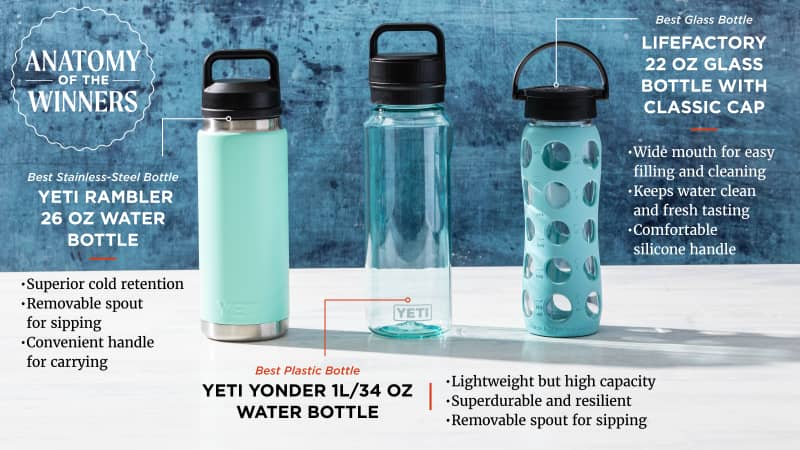
Consider Materials First
Although design and size are important when shopping for a water bottle, the first consideration should be material. There are three main types—stainless steel, plastic, and glass—and each has pros and cons. Plastic bottles tend to be 6 to 11 ounces lighter than glass and stainless-steel bottles, which makes them ideal for long walks and hikes or for anyone who doesn’t want to add too much weight to their bags. However, plastic bottles won’t keep water cold for long periods and can sweat. Stainless-steel bottles are durable, and double-walled versions provide great insulation and can keep water below room temperature for more than 8 hours. They also don’t collect condensation. One drawback is their weight. Some testers complained that they were too heavy; on average, stainless-steel water bottles weigh nearly 3 pounds when full. If you want to avoid plastic or the heaviness of stainless steel, a glass bottle may work for you. Glass bottles are ideal for people who want the closest experience to drinking from a regular glass but with added portability. The downsides are they’re not great at keeping water cold, some can be heavy, and they’re fragile compared to plastic and stainless steel.
Which Water Bottle Style Is Right For You?
Style | Style 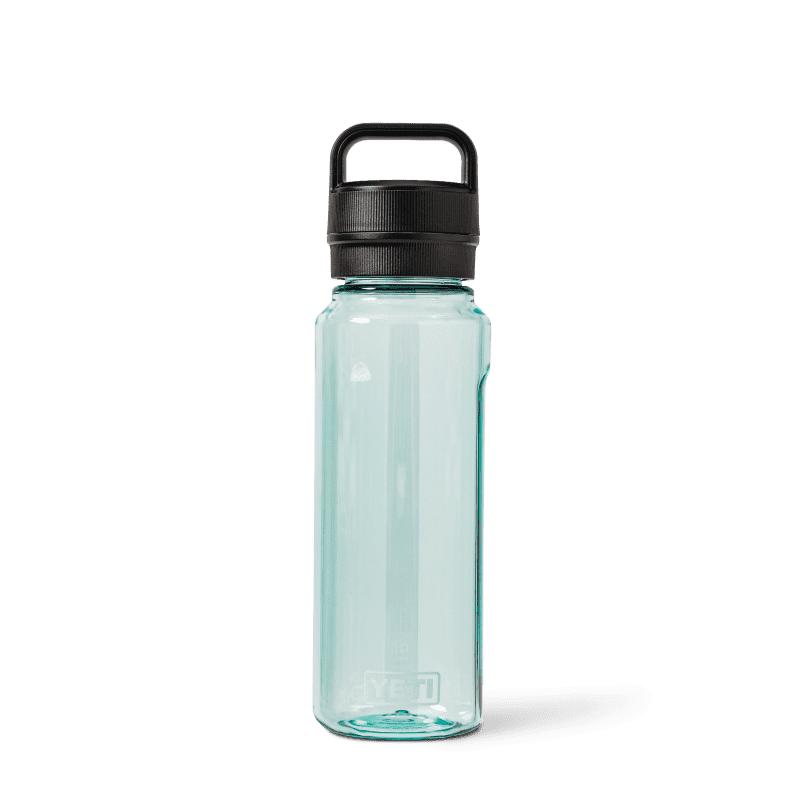 Best Plastic Bottle Plastic BottleBuy on Amazon ▸ | Style 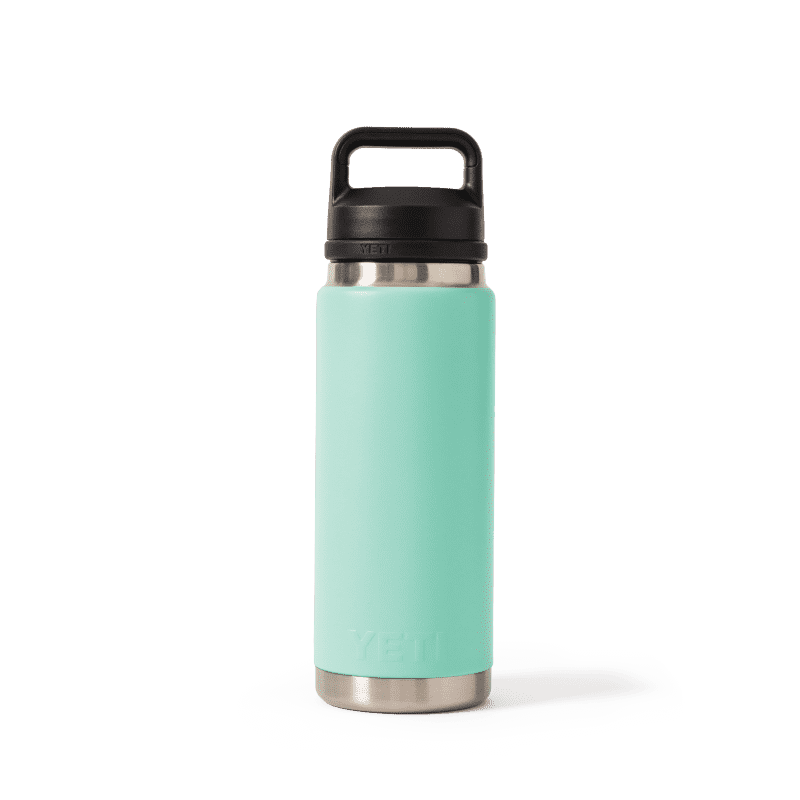 Best Stainless-Steel Bottle Stainless-Steel BottleBuy on Amazon ▸ | Style 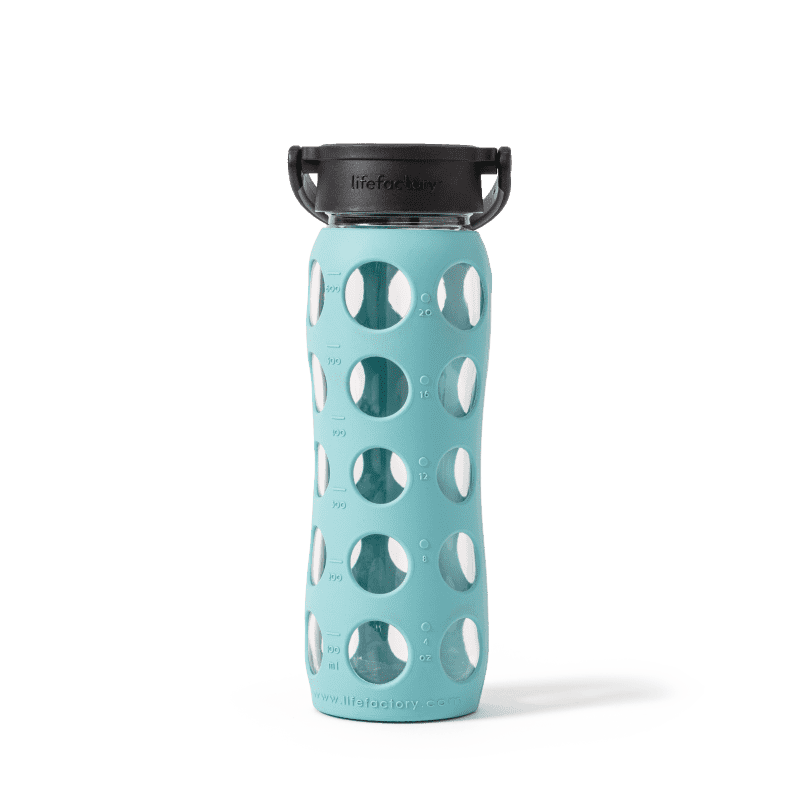 Best Glass Bottle Glass BottleBuy on Amazon ▸ |
|---|---|---|---|
Leakproof? | Leakproof? yes | Leakproof? yes | Leakproof? yes |
Dishwasher safe? | Dishwasher safe? yes | Dishwasher safe? yes | Dishwasher safe? yes |
Weight when empty | Weight when empty 10.9 oz | Weight when empty 1 lb, 5.6 oz | Weight when empty 1 lb, 2.6 oz |
Weight when full | Weight when full 2 lb, 12.8 oz | Weight when full 2 lb, 15.6 oz | Weight when full 2 lb, 8.6 oz |
Durability | Durability Highly durable—can sustain small tumbles and high drops | Durability Highly durable—can sustain small tumbles and high drops | Durability Moderately durable—can sustain small tumbles but will shatter from high drops |
Cold retention | Cold retention 4 hours | Cold retention 8+ hours | Cold retention 3 hours |
Interchangeable spout? | Interchangeable spout? yes | Interchangeable spout? yes | Interchangeable spout? Yes (sold separately) |
Best for | Best for Hikers/walkers, or anyone who doesn’t want to add much weight to their bag or luggage | Best for People who want cold water all day | Best for People who want to avoid drinking from plastic |
The Different Types of Mouthpieces
Once you choose a material, you’ll need to decide how you want to sip or drink from your water bottle. With some models, you drink directly from the mouth of the bottle. Others have a spout, a flip-down straw, or a bite valve. Like the materials the bottles are made from, each style has benefits and drawbacks. Wide mouths are easier to fill and clean but can lead to more spills while drinking or chugging. Narrow mouths are less likely to spill but are harder to clean with a bottle brush and are not as easy to fill. Flip-down straws allow you to sip and then fold the straw into a nook in the lid when not in use, but the straws can be difficult to rinse thoroughly. Bite valves require you to bite down on a mouthpiece to release the flow of water. This was the only style that testers didn’t enjoy using; the devices were uncomfortable and often trapped water or food.
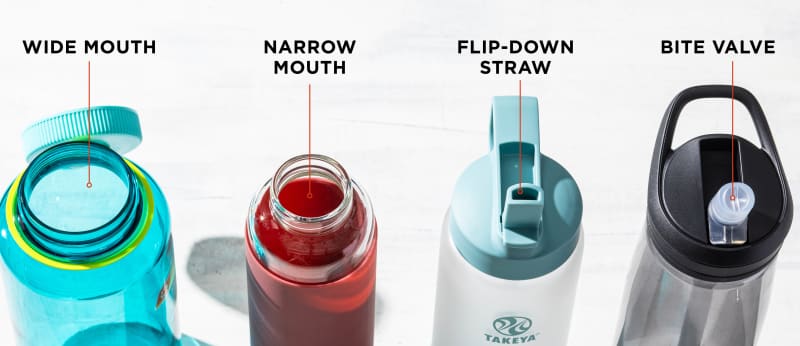
What About Capacity?
The size of the bottle you choose depends on your individual preferences and how you plan to use the bottle. The capacities of the bottles we tested ranged from 20 to 34 ounces. Testers who liked smaller-capacity bottles didn’t mind refilling them throughout the day. Conversely, testers liked larger-capacity bottles for walks or short hikes. Read on to see why we picked our favorites.

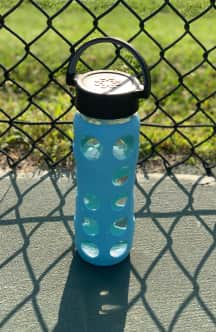

We asked 12 testers to use their water bottles during everyday activities such as working, exercising, or driving.
What to Look For
- Easy-to-Use Drinking Spouts and Straws: We liked drinking from many of the water bottles we tested. Our favorites had wide mouths or comfortable spouts that allowed us to take substantial sips without risk of spilling. For models with straws, we preferred those that weren’t too bulky.
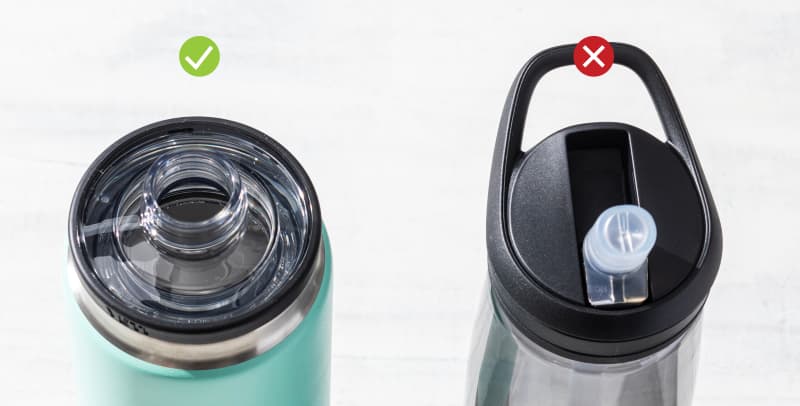
- Leakproof, Durable Models: We deducted points from models that leaked when we ran them through our various tests. Bottles that could withstand a fall off a table received high marks, but we didn’t deduct points if they sustained a few scratches and minor dents when dropped on concrete.
- Wide Openings for Cleaning and Filling: We preferred dishwasher-safe bottles but also liked models that we could easily hand-wash as well. Bottles with wide openings (at least 2¼ inches wide) allowed us to fit a bottle brush inside to scrub the interior comfortably. They were also easier to fill.
- Comfortable Handle for Carrying: We liked bottles with handles that had an opening of at least an inch so that we could clip them onto bags or easily carry them.
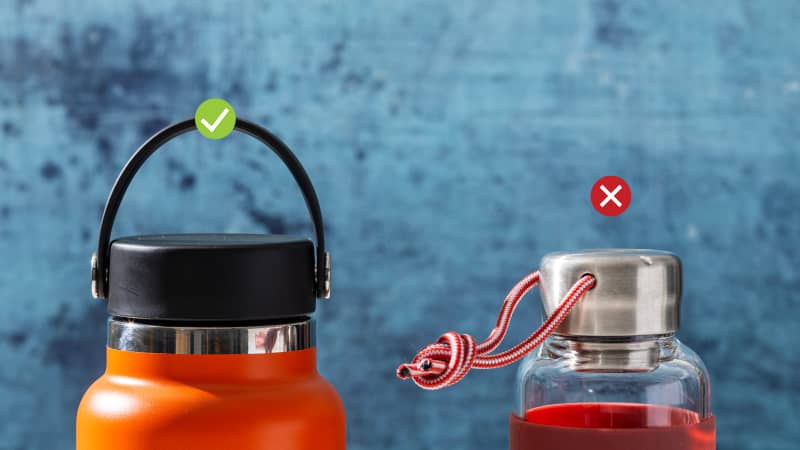
Nice to Have
- Drinking Accessories: Some companies make various interchangeable lids (both included and sold separately) with different spout and straw options that you can pair with their bottles depending on that day’s activity. These lids can be secured on top of a bottle and removed when filling or cleaning it. Although not necessary, screw-on spouts and straws made drinking less messy. If you like to chug, get a wide-mouth bottle with a screw-on cap that allows you to drink with little risk of spilling. For people who tend to sip water throughout the day, a bottle with a straw is a convenient feature.
What to Avoid
- Hard-to-Open Lids: When lids screwed on too tightly, we strained our hands when we tried to open them. We were more prone to leave the lid off the bottle, which could lead to spills.
- Hard-to-Clean Models: One bottle with a bite valve trapped bits of food and water. We also didn’t like it when we couldn’t fit a sponge or bottle brush in the crevices of lids to clean them thoroughly.

- Leaky Bottles: Bottles that leaked were a nuisance and messy when we put them in a bag. One model was quite finicky. There was a plunger on the lid that we had to take care to press down fully; if we didn’t, the lid didn’t seal completely, and water leaked through the opening.
The Tests
- Fill bottles with water and drink from them
- Put each water bottle in backpack, walk around neighborhood, and then inspect for leaks
- Leave bright-colored sports drink in bottles overnight and then inspect for any stains or odors
- Open and close each bottle 20 times
- Knock bottles onto kitchen floor from height of 3 feet; drop bottles from height of 6 feet onto concrete
- Wash 10 times according to manufacturer instructions
- Recruit 12 people to use water bottles for 2 weeks and then record their responses
How We Rated
- Ease of Use: We evaluated how easy the bottles were to open, close, fill, drink from, and use throughout the day. If they had handles, we noted how comfortable they were to hold.
- Cleanup: We assessed how easy the bottles were to clean after just holding water and after leaving sports drinks in them overnight.
- Durability: We considered whether the bottles suffered significant damage when dropped from a table or outside on concrete.
